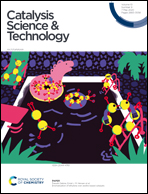Deboronation-assisted construction of defective Ti(OSi)3OH species in MWW-type titanosilicate and their enhanced catalytic performance†
Abstract
A thorough investigation of the nature of the Ti species in the boron-containing Ti-MWW zeolite has been carried out. It was found that the inactive extra-framework TiO6 species can cover up the zeolite Lewis-acid property through the weak atomic binding forces between the “Ti(IV)” atom and “O” atom (TiO6 species). The nitric acid treatment could remove these TiO6 species easily from the as-synthesized Ti-MWW(P), followed by exposure of the zeolite Lewis acidity. Importantly, the formation of new Ti(OSi)3OH species with a strong Lewis-acid strength, is facilitated in the modification process. Thereby, the modified Ti-MWW zeolite has an improved catalytic activity in alkene epoxidation reactions. The removal of framework B(IV) species around the TiO4 species is an essential step because it can accelerate the transformation of perfect Ti(OSi)4 species to the defective Ti(OSi)3OH species in zeolites. Moreover, the strategy to construct Ti(OSi)3OH species was also applied successfully in boron-containing Ti-MCM-56 zeolites. Considering active species environment can be modulated effectively with the removal of framework tetra-coordinate boron, this strategy could also be beneficial for the preparation of other high-performance titanosilicates.



 Please wait while we load your content...
Please wait while we load your content...